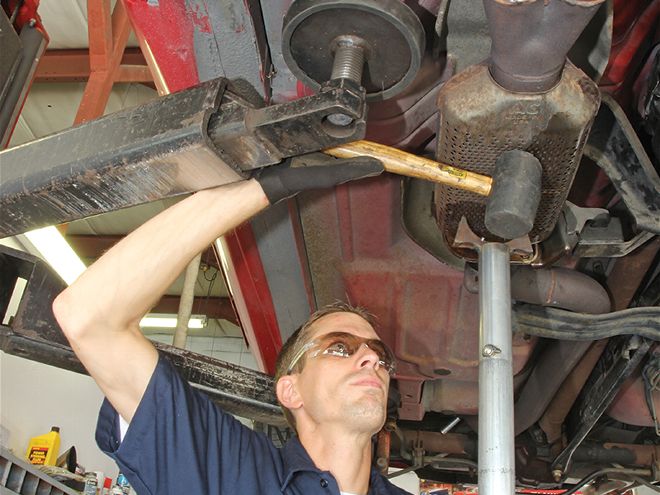
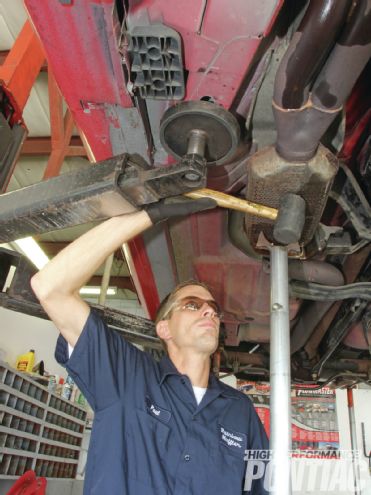 Rainbow Muffler General Manager Paul Grosskopf demonstrates a simple test to determine if a catalytic converter’s substrate is loose. He taps on the converter’s aluminized-steel underbelly with a rubber mallet. If he hears a rattling sound, the substrate is loose and the converter needs to be replaced. Ours did. (This won’t work on the ’70s pellet-type converters, since the pellets are already loose.)
Rainbow Muffler General Manager Paul Grosskopf demonstrates a simple test to determine if a catalytic converter’s substrate is loose. He taps on the converter’s aluminized-steel underbelly with a rubber mallet. If he hears a rattling sound, the substrate is loose and the converter needs to be replaced. Ours did. (This won’t work on the ’70s pellet-type converters, since the pellets are already loose.)
Like you, we're intimately aware of our Pontiac's performance every time we get behind the wheel of it and push the go pedal. If power seems off by even the slightest bit, we begin to mentally troubleshoot what system or component in the drivetrain or elsewhere may be the root of the subtle (or sometimes not so subtle) performance loss we sense.
Our '95 Firehawk was experiencing power-loss symptoms, which were consistently troubling. Idle was fine, but the moment we applied even the lightest throttle above 1,000 rpm, the car would buck and sputter. To drive it from point A to point B, we had to maintain 2,000 rpm or higher, and even then it felt like something sinister had a super-villian-strength stranglehold around our engine's neck.
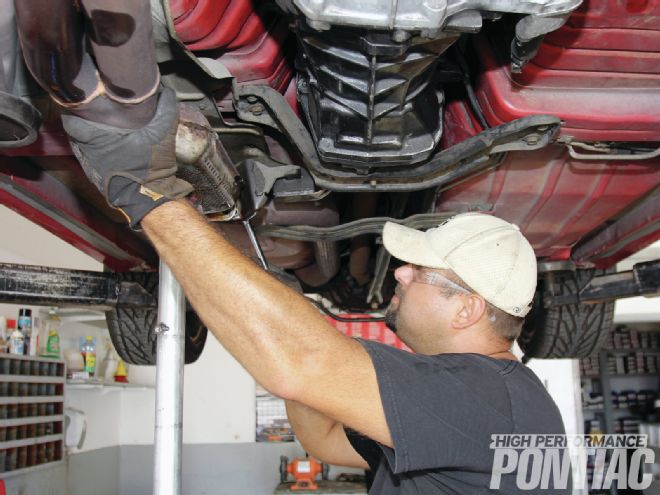 1 Shop technician Nathaniel Pollard removes the factory OE Y-pipe, which on this Pontiac houses a single in-line converter. (Depending on the year of your ’75-and-up Pontiac, you may have one converter or two.) No cutting is required, since the assembly bolts up with two 5⁄16-inch bolts to the downpipe, and two more 5⁄16-inch bolts to the midpipe.
1 Shop technician Nathaniel Pollard removes the factory OE Y-pipe, which on this Pontiac houses a single in-line converter. (Depending on the year of your ’75-and-up Pontiac, you may have one converter or two.) No cutting is required, since the assembly bolts up with two 5⁄16-inch bolts to the downpipe, and two more 5⁄16-inch bolts to the midpipe.
For all the sophistication of the myriad diagnostic sensors in our Firehawk, the engine control module (ECM) was not reporting a diagnostic trouble code (DTC), which we expected would point us to the proverbial smoking gun. We checked fuel pressure, spark, incoming airflow, and the oxygen sensors to manually find a problem the sensors could not. Nothing. It was perplexing.
Then Autoway Chevrolet service advisor Chris Sullo in Clearwater, Florida, suggested something: "It could be the catalytic converter."
He referred us to Rainbow Muffler in Largo, where owner Paul Grosskopf was willing to give us a second opinion. After test-driving the Firehawk and validating our concerns, he raised our Firebird on his lift, grabbed a rubber mallet from his tool chest, tapped on the converter's underbelly, and listened to the resulting sound. "Do you hear that?" he asked. "That's the substrate rattling. It has come loose and is obstructing exhaust flow to the muffler."
It's not common practice to repair catalytic converters, though it was, way back in the mid to late-'70s, when the industry was in its infancy. If one goes bad these days, you replace it. Factory converter assemblies, which often include a Y pipe, are expensive-ours was over $1,000 from a local GM parts counter.
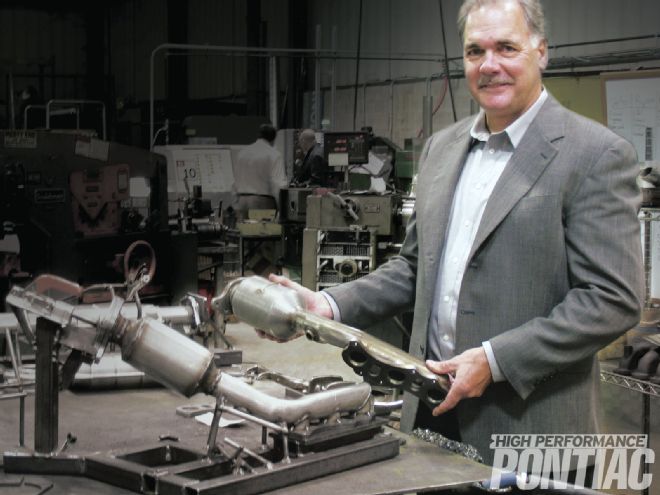 2 Eastern Catalytic Converter founder and President George Schafer demonstrates how his company validates OE fit for its direct-fit cats in application-specific jigs. “We think we’re one of the few manufacturers in the industry that brings a test vehicle into our shop, takes the OE exhaust off, makes a jig, and builds our products from that.” Schafer says. “My company has over 4,000 such vehicle-specific jigs in stock.”
2 Eastern Catalytic Converter founder and President George Schafer demonstrates how his company validates OE fit for its direct-fit cats in application-specific jigs. “We think we’re one of the few manufacturers in the industry that brings a test vehicle into our shop, takes the OE exhaust off, makes a jig, and builds our products from that.” Schafer says. “My company has over 4,000 such vehicle-specific jigs in stock.”
Some hobbyists hollow out their converters or remove them completely, but neither is a good idea. Here's why. Reputable exhaust shops will refuse to do it because federal law makes it illegal to remove a symptomatic catalytic converter from a passenger vehicle originally equipped with one, unless it's replaced with one that has a similar design and function.
That led us to the idea of researching aftermarket catalytic converters. We learned Eastern Catalytic, based in Langhorne, Pennsylvania, has been manufacturing them since 1976.
"The founders had a muffler shop in the Philadelphia area, and began getting requests to rebuild first-generation factory converters, which had a high failure rate," says Eastern's Emissions Certification Engineer Charlie Pantano. "Before long, the company started purchasing new ceramic substrate to use in new aftermarket converters. Today, Eastern supplies aftermarket converters to over 58 countries, including, of course, the United States."
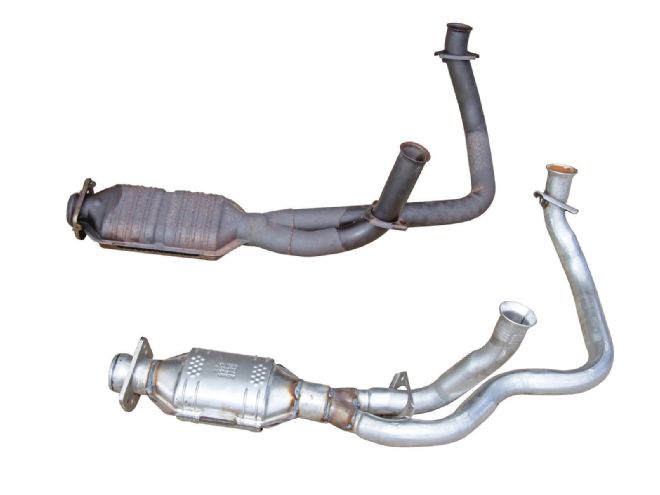 3 The OE assembly, shown here at the top, will be replaced by the new Eastern cat/Y-pipe assembly shown at the bottom.
3 The OE assembly, shown here at the top, will be replaced by the new Eastern cat/Y-pipe assembly shown at the bottom.
He then told us Eastern manufactures direct-fit catalytic converters for all Pontiacs from '75 forward. We ordered the correct assembly for our '95 V-8 Firebird (PN 50262; MSRP $685.89), and it was delivered in a few days. We show you the install in the photography that accompanies this story. Afterwards, we sent the Firebird's failed, factory catalytic converter to Eastern Catalytic for analysis. Here's what we learned:
"The converter experienced what we call loose block or broken substrate," Pantano said. "Without actually testing your engine, we can speculate from past experience that the major cause comes from problems that include engine misfires and leaky fuel injectors. Both conditions cause unburned fuel to leave the combustion chamber and become ignited on the surface of the catalytic converter. The explosion on the surface causes high temperatures that can burn the matting, resulting in the loss of holding force on the ceramic substrate.
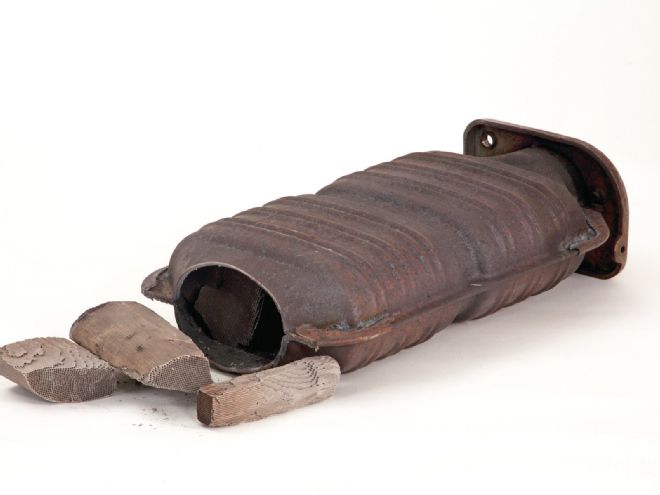 4 We sent our GM converter to Eastern Catalytic Converter for its engineers to examine. Here’s what fell out of our cat when they opened it up—three chunks of substrate, which were almost completely blocking the exhaust flow downstream.
4 We sent our GM converter to Eastern Catalytic Converter for its engineers to examine. Here’s what fell out of our cat when they opened it up—three chunks of substrate, which were almost completely blocking the exhaust flow downstream.
"Over time, the substrate rattles around inside of the shell and becomes broken up. The broken bits of debris can become lodged in the other section of converter or stuck in the muffler assembly further downstream.
"In the Firebird's case, the substrate was broken up into small pieces and was blocking the holes in the second substrate, causing poor engine performance."
[Note: Our subsequent research and diagnosis revealed that the Firebird was not misfiring and didn't have a leaky injector, either. When our Optispark unit failed, the Firebird's fuel system dumped raw fuel into the combustion chamber every time we cranked the ignition. That unburned fuel made its way downstream into the catalytic converter.]
If your '75-or-newer Pontiac has a gradual or sudden loss of power, and you've exhausted all troubleshooting for fuel, air, and spark systems, you may, like us, find that the culprit is a failed factory catalytic converter.
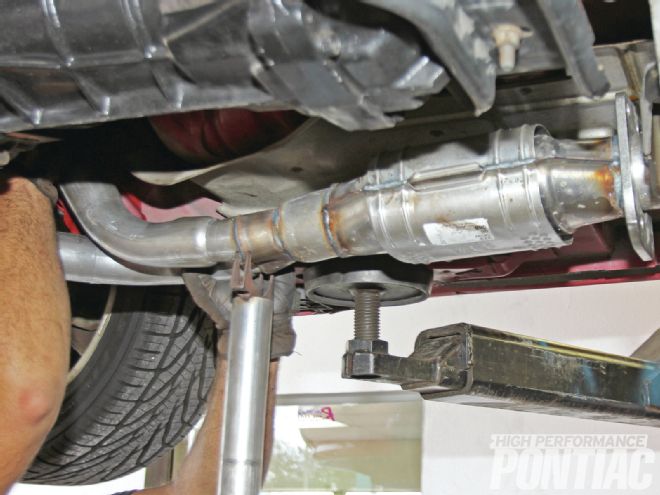 5 Pollard installs the new cat/Y-pipe assembly just like he would an OE unit, reusing the factory bolts and nuts. Notice how the flange at the front of the cat mates up to the downpipe …
5 Pollard installs the new cat/Y-pipe assembly just like he would an OE unit, reusing the factory bolts and nuts. Notice how the flange at the front of the cat mates up to the downpipe …
Follow along to see how Rainbow Muffler technicians identify the catalytic converter failure, remove the OE unit, and install Eastern Catalytic's direct-fit replacement. Next month be sure to check out our story "Preventing 'Cat'astrophe," in which we show you the preventable causes of catalytic-converter failure.
Note: Eastern Catalytic sells through retail stores and Internet sites, such as eBay Motors. Though it can't sell to you directly, Eastern is happy to answer your questions regarding the correct catalytic-converter assembly for your specific application.